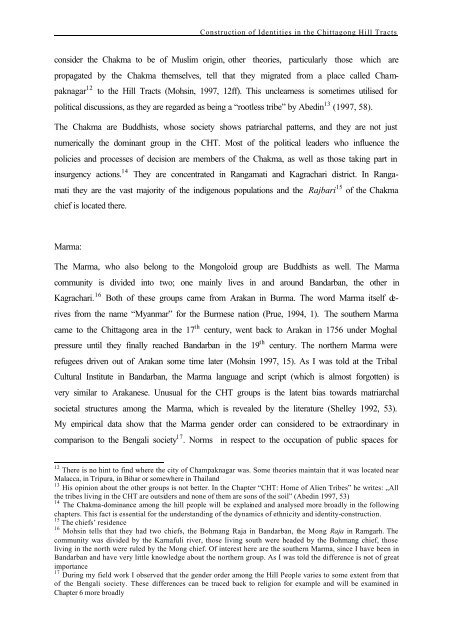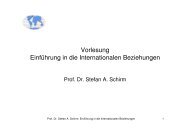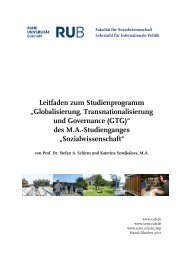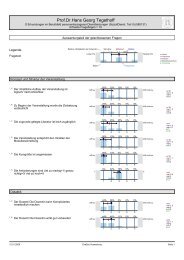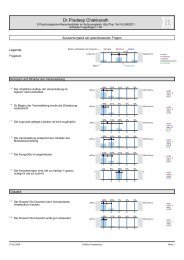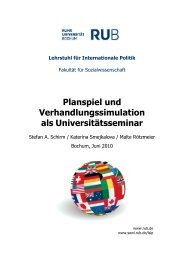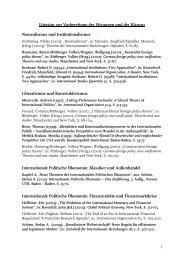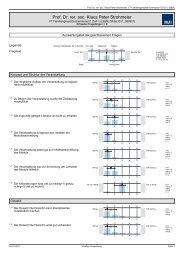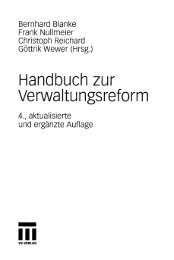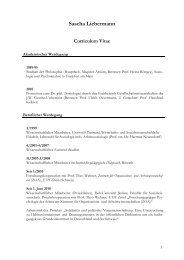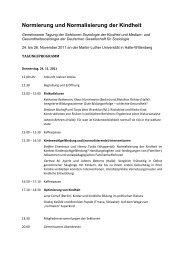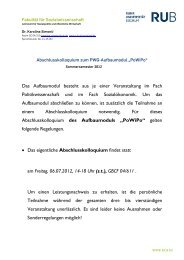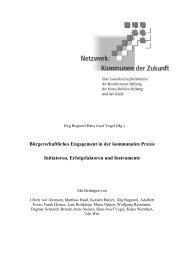Eva Gerharz: âThe Construction of Identities: The Case of the Chitta ...
Eva Gerharz: âThe Construction of Identities: The Case of the Chitta ...
Eva Gerharz: âThe Construction of Identities: The Case of the Chitta ...
Create successful ePaper yourself
Turn your PDF publications into a flip-book with our unique Google optimized e-Paper software.
<strong>Construction</strong> <strong>of</strong> <strong>Identities</strong> in <strong>the</strong> <strong>Chitta</strong>gong Hill Tracts<br />
consider <strong>the</strong> Chakma to be <strong>of</strong> Muslim origin, o<strong>the</strong>r <strong>the</strong>ories, particularly those which are<br />
propagated by <strong>the</strong> Chakma <strong>the</strong>mselves, tell that <strong>the</strong>y migrated from a place called Champaknagar<br />
12 to <strong>the</strong> Hill Tracts (Mohsin, 1997, 12ff). This unclearness is sometimes utilised for<br />
political discussions, as <strong>the</strong>y are regarded as being a “rootless tribe” by Abedin 13 (1997, 58).<br />
<strong>The</strong> Chakma are Buddhists, whose society shows patriarchal patterns, and <strong>the</strong>y are not just<br />
numerically <strong>the</strong> dominant group in <strong>the</strong> CHT. Most <strong>of</strong> <strong>the</strong> political leaders who influence <strong>the</strong><br />
policies and processes <strong>of</strong> decision are members <strong>of</strong> <strong>the</strong> Chakma, as well as those taking part in<br />
insurgency actions. 14 <strong>The</strong>y are concentrated in Rangamati and Kagrachari district. In Rangamati<br />
<strong>the</strong>y are <strong>the</strong> vast majority <strong>of</strong> <strong>the</strong> indigenous populations and <strong>the</strong> Rajbari 15 <strong>of</strong> <strong>the</strong> Chakma<br />
chief is located <strong>the</strong>re.<br />
Marma:<br />
<strong>The</strong> Marma, who also belong to <strong>the</strong> Mongoloid group are Buddhists as well. <strong>The</strong> Marma<br />
community is divided into two; one mainly lives in and around Bandarban, <strong>the</strong> o<strong>the</strong>r in<br />
Kagrachari. 16 Both <strong>of</strong> <strong>the</strong>se groups came from Arakan in Burma. <strong>The</strong> word Marma itself derives<br />
from <strong>the</strong> name “Myanmar” for <strong>the</strong> Burmese nation (Prue, 1994, 1). <strong>The</strong> sou<strong>the</strong>rn Marma<br />
came to <strong>the</strong> <strong>Chitta</strong>gong area in <strong>the</strong> 17 th century, went back to Arakan in 1756 under Moghal<br />
pressure until <strong>the</strong>y finally reached Bandarban in <strong>the</strong> 19 th century. <strong>The</strong> nor<strong>the</strong>rn Marma were<br />
refugees driven out <strong>of</strong> Arakan some time later (Mohsin 1997, 15). As I was told at <strong>the</strong> Tribal<br />
Cultural Institute in Bandarban, <strong>the</strong> Marma language and script (which is almost forgotten) is<br />
very similar to Arakanese. Unusual for <strong>the</strong> CHT groups is <strong>the</strong> latent bias towards matriarchal<br />
societal structures among <strong>the</strong> Marma, which is revealed by <strong>the</strong> literature (Shelley 1992, 53).<br />
My empirical data show that <strong>the</strong> Marma gender order can considered to be extraordinary in<br />
comparison to <strong>the</strong> Bengali society 17 . Norms in respect to <strong>the</strong> occupation <strong>of</strong> public spaces for<br />
12 <strong>The</strong>re is no hint to find where <strong>the</strong> city <strong>of</strong> Champaknagar was. Some <strong>the</strong>ories maintain that it was located near<br />
Malacca, in Tripura, in Bihar or somewhere in Thailand<br />
13 His opinion about <strong>the</strong> o<strong>the</strong>r groups is not better. In <strong>the</strong> Chapter “CHT: Home <strong>of</strong> Alien Tribes” he writes: „All<br />
<strong>the</strong> tribes living in <strong>the</strong> CHT are outsiders and none <strong>of</strong> <strong>the</strong>m are sons <strong>of</strong> <strong>the</strong> soil” (Abedin 1997, 53)<br />
14 <strong>The</strong> Chakma-dominance among <strong>the</strong> hill people will be explained and analysed more broadly in <strong>the</strong> following<br />
chapters. This fact is essential for <strong>the</strong> understanding <strong>of</strong> <strong>the</strong> dynamics <strong>of</strong> ethnicity and identity-construction.<br />
15 <strong>The</strong> chiefs’ residence<br />
16 Mohsin tells that <strong>the</strong>y had two chiefs, <strong>the</strong> Bohmang Raja in Bandarban, <strong>the</strong> Mong Raja in Ramgarh. <strong>The</strong><br />
community was divided by <strong>the</strong> Karnafuli river, those living south were headed by <strong>the</strong> Bohmang chief, those<br />
living in <strong>the</strong> north were ruled by <strong>the</strong> Mong chief. Of interest here are <strong>the</strong> sou<strong>the</strong>rn Marma, since I have been in<br />
Bandarban and have very little knowledge about <strong>the</strong> nor<strong>the</strong>rn group. As I was told <strong>the</strong> difference is not <strong>of</strong> great<br />
importance<br />
17 During my field work I observed that <strong>the</strong> gender order among <strong>the</strong> Hill People varies to some extent from that<br />
<strong>of</strong> <strong>the</strong> Bengali society. <strong>The</strong>se differences can be traced back to religion for example and will be examined in<br />
Chapter 6 more broadly


